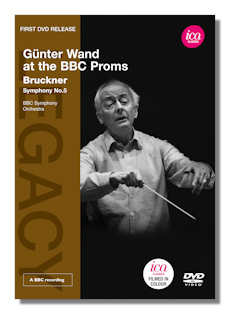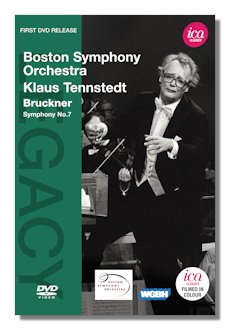
The Internet's Premier Classical Music Source
Related Links
- Bruckner Reviews
- Latest Reviews
- More Reviews
-
By Composer
-
Collections
DVD & Blu-ray
Books
Concert Reviews
Articles/Interviews
Software
Audio
Search Amazon
Recommended Links
Site News
 DVD Review
DVD Review
Anton Bruckner

Symphony #5
BBC Symphony Orchestra/Günter Wand
ICA Classics DVD ICAD5049 79m LPCM Stereo Full Screen


Symphony #7
Boston Symphony Orchestra/Klaus Tennstedt
ICA Classics DVD ICAD5066 66m Enhanced Mono Full Screen
ICA Classics is the in-house label of the International Classical Artists artist management agency. It puts out historical recordings in its Legacy series, as well as live recordings of its own artists in its Live series. The Legacy series has four Bruckner DVD recordings – in addition to the two reviewed here, the catalog features Bruckner's 8th, played by the Boston Symphony under William Steinberg (ICA DVD 5071) and the 7th, played by Charles Munch, also with the Boston Symphony. The Wand 5th was recorded live at the Proms in September 1990, when Wand was a sprightly 78, while the Tennstedt 7th was captured in November 1977, relatively early in Tennstedt's career outside East Germany (he had defected only in 1971).
The Günter Wand DVD has a bonus interview with the conductor – Michael Berkeley is the interviewer (although in 2:54 there is not much time for him to shape the conversation!). Wand says some very insightful things about Bruckner, and it is definitely worth watching the interview before listening to the performance. One thing Wand emphasizes is the importance of steady tempi in Bruckner – as he puts it, "rubato can make the whole edifice collapse".
The 5th Symphony, Bruckner's most austere work, is very well suited to Wand's architectural approach, particularly in the last movement where pride of place is taken by a fugue and then a magnificent double fugue. Wand delivers a very compelling performance. His conducting is light on gesture and emphasis, but communicates a clear vision of the 5th symphony's complex structure. The final coda rightfully brought the house down.
Tennstedt has a very different conducting style to Wand. He is much more prone to rubato and variable tempi. Some passages sound as slow as I can remember hearing them. The comparison between Wand and Tennstedt is very much between Wand's structural conception and Tennstedt's emphasis on shaping the individual phrase – wood vs. trees, one might put it, a little unkindly. Of the four movements, the Adagio emerged most clearly in Tennstedt's hands. The structure was brought out, while there was wonderful attention to sonic detail. The coda was played almost like a piece of chamber music. Overall, however, the performance does not convince.
The sound in the Wand recording is good, while the Tennstedt recording leaves something to be desired (with the strings sounding a little subdued, although the brass emerges clearly). Brucknerians will certainly want to add the Wand to their ever-expanding Wand discography. The Tennstedt is for enthusiasts only, however.
Copyright © 2012, José Luis Bermúdez





















